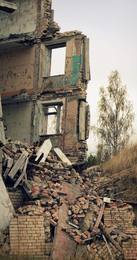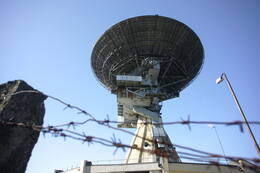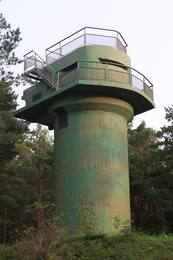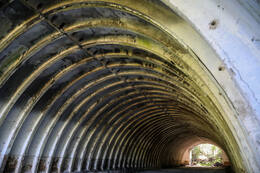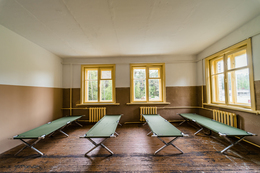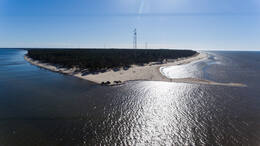"Arms Race" IV Soviet Occupation
In the early 1950s to late 1980s, competition between the United States and the USSR involved causing or participating in military conflicts in different parts of the world, building satellite regimes, seeking new allies, competing economically and politically and exchanging mutual accusations to build influence while reducing that of the other side.
Related timeline
Related objects
Zvaigznīte - Irbene military buildings
The 200-hectare site was once a top-secret military base occupied by military unit 51429.
Fire correction tower of the Ventspils 46th Coastal Defence Battery
The restored fire control tower of the 46th Coast Guard Battery in Ventspils is located on Saulrieta street and is available to visitors in the form of an observation tower. There are four artillery gun positions near the tower and it is the only World War II coastal defence battery in Latvia in such a good condition. Visitors can take the tower stairs to an outdoor viewing platform overlooking the sea. An information stand with a QR code is available next to the tower. You can use the QR to watch an animation about historical events. There is a new street leading to the tower, a large parking lot and a wooden footbridge that crosses the protected nature area next to the tower.
This military complex was built in 1939, marking the start of construction of USSR military bases in Latvia. The 46th Coast Guard Battery had four positions for the gun type Б-13. This battery had its first military engagement on 24 June 1941, when Ventspils harbour was attacked by German torpedo boats that were driven away from the shores of the Baltic Sea by battery fire. On June 28 the Soviet Army blew up the guns and left.
Barta missile base
Paplak Regiment. Barta - South, Barta - North. The base has been destroyed by man and nature. The buildings are taken back by the forest, the missile transport trucks and the missile hangars themselves are demolished. The communication centre has also been destroyed and most of the metal launch platforms have been dismantled.
According to official information, the following Soviet army units were located in the municipality of Barta:
49028 - 279. BKF naval transmitting centre
25026, 49393 - 30th BKF ship missile and nuclear warhead depots
49281 - Communications Department
20480 - 523rd Communications Centre Sub-unit
1994, leaving Latvia (The last military personnel to leave Latvia, the Barta missile base equipment, left the port of Liepaja on 31 August 1994.), submitted by the North-Western Troops Group of the Russian Federation. During the survey of the Barta missile base area, we also found the launch sites of the R-5M (8K51M) ballistic missile (NATO classification - SS-3 Shyster) with its adjacent command bunkers. The R-5M (8K51M) missiles with nuclear warheads were the first to be deployed by the occupying forces in Latvia in 1954, in the Barta forest of the Liepāja district. By decision No 700-330 of the Ministry of Defence of the USSR of 2 July 1985 (!), 2 623 hectares of land were allocated to troop unit No 42341 (50th Rocket Army in Smolensk, k/d 55135) in the Barta Forest. Two divisions of the 117th Rocket Regiment are stationed there. Each division has 4 missiles. On 18 September 1959, the Army requests a further 385,25 ha for five sites near Barta Brienampurva. Gravel for the construction of the base and for filling and camouflaging the hangars was brought from the nearby Krute quarry. Farmers are evicted from the houses of Kalnāji, Placēņi, Purviči, Zemturu, Purvu, Knīpupju, Mazturu, Birzmali in the municipality of Barta. The losses for the liquidation of 8 farms shown in the archive documents are only 154 711 roubles. All the constructions of the bases were taken to Barta only at night, so that nobody would see them. But the inhabitants of Barta have always known: when the army starts grading the roads, they will be carrying something.In 1968, the surface-launch rocket divisions of Barta were disbanded. The modernised shaft rockets (R-12 and R-14) are not deployed in Barta because the site is located in a marshy area.
Soviet army military base in Pāvilosta - active recreation centre
During the Soviet era, a border guard unit was located here, other Soviet army units - liaison officers and a surface-to-air missile base were located several kilometres away in the forest. After independence, the Latvian army was stationed there.
The former Soviet army military base is now a recreation, leisure and camping centre - for personal development in interaction with nature and the people around.
A place for recreation and accommodation for both tourist groups and families. Rooms, showers, WC, fireplaces, spacious area for activities, sounds of nature. Book in advance by calling +371 26314505.
Olman Battery No.456 (Soviet military base "Krasnoflotska")
The first coastal defence batteries for the defence of the Irbe Strait were built after 1912, when the Baltic Fleet Mine-Artillery Defence Position Plan was approved, which included several coastal defence batteries and sea mine-laying.
The Irbe Strait position was the furthest south, and its task was to block any enemy access to the Gulf of Riga. The main emphasis was on sea mines, tens of thousands of which were laid in the Irbe Strait during WWI by ships of the Baltic Fleet. It was not until 1916 that coastal defence batteries began to be built on the southern tip of the island of Saaremaa, Cape Sorve. Seven batteries were built in total, and Battery 43 was equipped with 305 mm guns. No defence batteries were built on the Latvian coast of the Irbe Strait.
Even after the establishment of the Republic of Latvia, the Latvian army and navy did not establish artillery positions to defend the Irbe Strait.
The situation changed after the mutual assistance pact between the Republic of Latvia and the USSR of 5 October 1939, which provided for a contingent of the Red Army and the Baltic Naval Fleet to be stationed in Kurzeme. Soviet plans also included the establishment of a coastal defence system based on the 1912 plan, with improvements. The plan was to build coastal defence batteries on the site of the Liepaja fortress, with new batteries south of Ventspils (Battery No 46) and two batteries in the narrowest part of the Irbe Strait near Mikeltornis. Already after the occupation and annexation of Latvia, the coastal defence plans of the Baltic Navy were supplemented and by June 1941 the 207th Artillery Division with five batteries was planned to be established in the northern part of Kurzeme. Two batteries were to be set up in the vicinity of Mikeltornis - Battery 40 at Lūžņa with 130 mm B-13 guns in reinforced concrete fortifications, and Battery 117 at Olmani (a place designated on Latvian army maps as Ķesteri) with 152 mm MU-2 guns. As the development of the 152 mm guns was not completed, temporary wooden platforms were built on the reinforced concrete fortifications of the battery and four more 130 mm guns were installed. Both batteries were completed by June 1941, but the batteries could not be traced in the war against the German 291st Infantry Division, and their crews moved to the island of Saaremaa.
At the end of WWII, the German Army Group "Courland" was quite serious about possible Soviet landings in northern Courland, especially after the ice melted in the Gulf of Finland and on the west coast of Estonia. Improvised coastal defence batteries were deployed all along the Kurzeme coast. The Soviet Battery No 40, Gerate Batterie Sommer of the 289th Artillery Division with two 122 mm Soviet howitzers, was stationed in reinforced concrete positions near Luzhne. In the area of Battery 117's position was Battery 2 of the 530th Artillery Division with three 152 mm Soviet trophy guns, three 37 mm zenith drones, one 20 mm four-barrel zenith drones, two 75 mm anti-tank guns and two mortars for illumination.
After the end of active hostilities in May 1945, the USSR began to rebuild the coastal defence system on the Kurzeme coast. In the autumn of 1945, a temporary Battery 456 with 152 mm guns of the Kane system was deployed near the Olmaņi farm, which was renamed "Krasnoflotskaya".
In 1952, the temporary guns of the battery were replaced by the latest 152 mm MU-2 weapon systems. The battery consisted of four reinforced concrete gun emplacements, a reinforced concrete command post with a range-finder turret and technical buildings. The construction of the battery was completed in 1958.
In 1958, after the dismantling of the Lūžņa coastal defence battery, it was replaced by a mobile 130 mm SM-4-1 gun Battery No 343. The mobile guns did not have reinforced concrete gun emplacements, but several log and sand structures were built.
Battery 343 operated until the early 1960s, and Battery 456 until 1975, when it was preserved. The battery positions were used to deploy S-125 air defence missile complexes, as well as the 10th Coastal Defence Artillery-Missile Regiment with CP-2 Sopka missile complexes, and the infrastructure was modified accordingly.
The Soviet Army transferred the infrastructure of the Olmaņi and Lūžņa batteries to the Republic of Latvia in 1993.
German army coastguard searchlight site in Usi and border guard post in Kolka
No military infrastructure was planned in Cape Kolka, except for several offshore lighthouses that were rebuilt over a long period of time, either before World War I, during World War I or during World War II. Coastal defence batteries were planned for the narrowest part of the Irbe Strait, between the Sirves Peninsula and the Michael Tower Lighthouse.
The only fortifications of a military nature appeared at the end of 1944, when the German Army Group North was preparing to repel possible landings by the Soviet Baltic Fleet. In the spring of 1945, after the ice retreated, two batteries of the 532nd Artillery Division defended the coast at Cape Kolka. Battery 7 with four 75 mm guns and three 20 mm zenith guns. Battery 8 with four 88 mm mortars, three 20 mm mortars and an 81 mm mortar. The anti-deserter infantry garrison consisted of one of the most famous coastal defence units of the German Navy, the 5th Company of the 531st Artillery Division. Although it was an artillery unit by name, it was an infantry unit by deployment, which started its war in June 1941 at Liepāja. The unit was then garrisoned on islands in the Gulf of Finland and later took part in the fighting on the island of Saaremaa. The remnants of the division were reformed into one company and, reinforced with seven anti-tank guns and three 20 mm anti-aircraft guns, deployed at Cape Kolka.
The Soviet naval landing operation never took place and the German units capitulated in May 1945.
The military infrastructure in Cape Kolka began to be built after the Second World War, when Soviet border guard posts were deployed here and Kolka, like the entire Kurzeme coast from Mērsrags to the Lithuanian border, became a closed zone
Private military collection in Mundigciems
Private military collection in Mundigciems. Aivars Ormanis has been collecting historical objects for many years - military uniforms, uniforms, camouflage, communication devices, household items, protective equipment from different periods and countries, dating back to the Second World War, the Soviet army and the restoration of independent Latvia.
The collection is currently not well maintained and the exhibits are housed in a former collective farm barn.
Monument to the dead fishermen and sailors and US airmen
250 metres south-west of Battery 6 is the Monument to Fishermen and Sailors, with a plaque to the US Navy PB4Y-2 Privateer scout plane shot down off Liepaja on 8 April 1950. The aircraft, nicknamed Turbulent Turtle, was part of Patrol Squadron 26 and took off from Wiesbaden airfield in the early hours of 8 April and, via Copenhagen, set off on a surveillance and possibly radio reconnaissance mission. According to the order, the aircraft could not approach closer than 20 nautical miles to the Kurland coast, but for some unknown reason it flew into the USSR's self-defined 12 nautical mile zone. Two La-11s of the Soviet 30th Guards Fighter Regiment intercepted and shot down the unarmed reconnaissance aircraft. The fate of the 10-strong crew of the downed aircraft is not known with certainty; there is conflicting information that all were killed or, alternatively, that some of the pilots survived and ended up in prisoner-of-war camps.
The crew:
AT1 Frank L. Beckman
AL3 Joseph J. Bourassa
ENS Tommy L. Burgess
AD 1 Joseph H. Danens
LT John H. Fette
CT3 Edward J. Purcell
LTJG Robert D. Reynolds
AN Joseph N. Rinnier
LT Howard W. Seeschaf
AD 1 Jack W. Thomas
Related stories
Why the Olympic Games were not held in Latvia...or submarine repairs in Daugavgrīva, at the Baltic Navy repair shop
When Moscow was preparing for the Summer Olympics in 1980, the question was where to hold the sailing competition? It turns out that the choice initially fell on Riga, because there are ideal conditions for sailing in the Gulf of Riga and the city is also old and beautiful, it will not be ashamed. However, some Riga residents still remember or the younger generation has read on the Internet that Riga "supposedly.. refused this high honor and therefore the organization of the competition was moved to Pirita, a suburb of Tallinn. The Estonians received huge funding and built themselves a new and modern complex for sailing and recreation, which after the end of the Olympics, not a single Latvian went to admire... But now one interesting nuance has been revealed - it has become known why Riga refused this honor...
Army presence on Mangalsala
The memories contain vivid impressions of the presence of the Latvian army on Mangalsala. The forts are described, as well as the reinforced concrete fortification built by Sapiers. The memories describe the soldiers' everyday life, the rhythm of life and illustrate the environment on Mangalsala. Visit of Mangalsala and Latvian army soldiers
Were nuclear warheads buried at Tukums airfield?
Former guard commander Aivars Skurstenis has come forward for an open conversation with the Tukums district newspaper “Neatkarīgās Tukuma Ziņas”. He was once a reserve officer and a field guard, who in 1993 was offered a position as a guard at the agricultural company “Durbe” led by Laimonis Mucenieks. There, he had to guard an office – the Līvāni house. That is how the story begins.
Military airfield near Tukums
The barely visible, grass-covered hangars by the highway to Tukums were home to army fighter jets during the Soviet era. Even in those days, the airfield and hangars were camouflaged, and the uninitiated had no idea about it.
About the Kolka Coast Border Guards
Kolka resident Valija Laukšteine's memories of the times in Kolka when there were border guards.
Border Guard Laundress
Kolka resident Mirdza Stankevica shares her memories of the times when she was a laundress.
Memories of the Kolka border zone
Kolka resident Biruta Freimane's memories of the border zone.
About the relations of Košradznieki with Soviet soldiers
Imants Upners' memories of the Soviet era.
Botanist's work on the seashore
While performing his duties as a botanist, he was only allowed to walk along the coast with a border guard.
Kolka Coast Guard Observation Tower
Hidden in the last pine trees of Cape Kolka is a border guard tower, where a border guard post was constantly located during the Soviet era, and the small stone building next to it is now abandoned and falling into ruin.
Kolka Cape Border Guard Observation Tower
During the Soviet era, border guards observed and controlled the waters of the Irbe Strait from this tower, and in those days it was said that even a duck could not swim through this strait without the border guards' knowledge.
Strangers in the border zone
Border guards had a unique way of finding out about strangers in the border area.
“Wind. Spite. And the Livonian flag.” (fragment) - Ghost Ships and Barbed Wire
Gunta Kārkliņa's memories of the Soviet era on the Livonian coast - how did the boat cemetery come about there?
Border regime zone
About times in the border regime zone.
Slītere State Reserve in the border regime zone
Memories of former employees of the Slītere State Reserve about the Soviet era.
Coastal battery at Olmaņi
North of Ventspils there is another important coastal battery. It was located in Olmaņi and was called "Krasnoflotskaya".
Damage to the Irbene radio telescopes
Before leaving Irbene, the Soviet army damaged all radio telescope systems
How someone escaped from border guards in Ventspils on a self-built boat
During the Soviet era, border patrol ships were based in the port of Ventspils, whose task was to patrol the waters of the Baltic Sea and prevent border crossings from either side – from the outside in or from the inside out. However, in the 1970s, an extraordinary incident occurred in Ventspils, about which the people of Ventspils have long whispered and laughed heartily.
Nature photos of the Uzava coast and Soviet border guards
The story of a protected plant photo in a border guard area.
"The Latvian SSR NPP will be here!"
Memories of Andris Zaļkalns (born 1951, Chairman of the Council of People's Deputies of the village of Vērgale (1982-1989)) about the time when a nuclear power plant was almost built in Akmeņrags.
About the former military facility of Upīškalns
Memories of Valdis Pigožnis during the operation of "Upīškalns" about Upīškalns military base
(Pigožnis was former head of Kurmale parish)
A mess of Krasnoflotskaya letters
There were interesting incidents in Soviet times with the name and geographical location of "Krasnoflotskaya"
The fate of Krasnoflotsk after the Soviet withdrawal
After the last Soviet troops left Latvia in 1993, the Krasnoflotsk or Olmani coastal defence battery also came into the possession of the Latvian National Defence Forces. Soon the orphaned property began to be seized by for-profit prospectors.
Stoning of tanks
During the Soviet era, the entire Kurzeme coast was a closed zone. Children who lived near the Soviet army unit in Targale parish, including Ovishi, used to have fun throwing stones at tanks.






